Racing
for Speed
Since
motor car was invented, human did not stop trying to raise top speed.
In
early days, such work was mainly because of practical needs, for
instance,
even the fastest pre-war car, Alfa Romeo 8C2900, can barely reached
125mph,
thus one can see how necessary to raise speed.
As
automotive technology developing, top speed became irreasonably high,
especially
after speed limits were legislated by governments. How many drivers
need
to travel at over 150mph? However, car makers still continued their
race
for speed, solely for the purpose of lifting their image. "The fastest
car in the world" is always a fascinating title, every sports car maker
wants to acquire it. The real battle started in the '60s by two of the
most admirable sports car makers - Lamborghini and Ferrari.
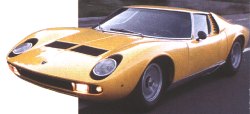 Ferruccio
Lamborghini established his company in the early '60s intended to rival
Ferrari. Of course, for a new sports car maker, the fastest way to make
name is to build "the fastest car in the world". Therefore in 1966, he
created the mid-engined, V12-powered Miura, the first 170mph sports car
in history. Ferruccio
Lamborghini established his company in the early '60s intended to rival
Ferrari. Of course, for a new sports car maker, the fastest way to make
name is to build "the fastest car in the world". Therefore in 1966, he
created the mid-engined, V12-powered Miura, the first 170mph sports car
in history.
2 years
later, Ferrari responded with front-engined Daytona, whose 4.4-litre
V12
developed more horsepower at 352hp. Road test found it was 2 mph faster
than Miura.
Enter
the '70s, the title of fastest car still controlled by these two
Italian
marques. In 1971 Geneva motor show, Lamborghini unveiled Countach
prototype,
which claimed to be 200mph ! However, when the production car launched
in 1974, old engine and inferior aerodynamics made it actually slower
than
Miura, although many people still believed it could do 200mph, simply
suggested
by its space-age styling. Luckily, Ferrari's contemporary mid-engined
512BB
also appeared to be slower than its predecessor, mostly because of smog
control.
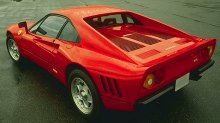 As
oil crisis hit the sports car market, the battle silent down for a few
years until 1984, when Ferrari launched its Group B limited production
supercar, 288GTO. Racing technology including Kevlar body, twin-turbo
32-valve
V8 engine helped it to taste 180mph top speed. 400hp was also a record
high in road car. Meanwhile, within a year, Maranello created another
supercar,
the boxer-engine Testarossa. 390hp from 12 cylinders enable the same
speed
as GTO, but this car is a production car which eventually built more
than
10,000 units. As
oil crisis hit the sports car market, the battle silent down for a few
years until 1984, when Ferrari launched its Group B limited production
supercar, 288GTO. Racing technology including Kevlar body, twin-turbo
32-valve
V8 engine helped it to taste 180mph top speed. 400hp was also a record
high in road car. Meanwhile, within a year, Maranello created another
supercar,
the boxer-engine Testarossa. 390hp from 12 cylinders enable the same
speed
as GTO, but this car is a production car which eventually built more
than
10,000 units.
At
the same time, Lamborghini upgraded its Countach LP500S to Countach
5000QV,
boasted by 5.2 litres 4-valve V12 good for 455hp. Due to inferior
aerodynamics,
it topped roughly the same as the Ferrari GTO and Testarossa. By the
way,
Aston Martin collaborated with designer / coach builder Zagato and
created
a car simply called "Zagato", with 432hp 5.3-litre V8 and a drag-free
body,
it was claimed to be capable of 187mph (300km/h) ! However, since only
50 were built, no wonder no test data was available.
When
nobody seems to be dominating, Porsche 959 stunned the world in 1987.
Built
according to Group B rules like Ferrari 288GTO, it also employed Kevlar
body and twin-turbo engine, but the Porsche flat six good for 450hp,
accompany
with 0.32 drag-coefficient, no wonder it reached 197mph in a test held
by AMS magazine.
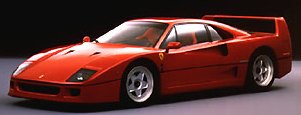 Ferrari
responded a year later with F40. Even more racy than the 959, but
twin-turbo
V8 output 478hp. Although overall performance was better, top speed was
marginally lower because of higher drag. Ferrari
responded a year later with F40. Even more racy than the 959, but
twin-turbo
V8 output 478hp. Although overall performance was better, top speed was
marginally lower because of higher drag.
Entered
the '90s, the competition raised to the toughest ever seen. Lamborghini
was lucky to launched its 202mph Diablo just before the new battle
broke
out, until now it is still the fastest production car. In 1992, Bugatti
EB110 raised the record to 211mph, Jaguar then recorded 217mph in its
XJ220
development car. Both of them were powered by a 3.5-litre turbocharged
engine.
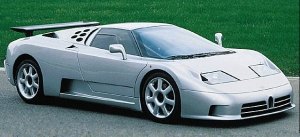 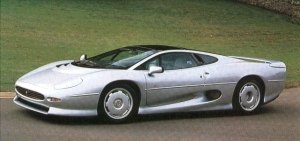 LEFT
: Bugatti EB110 Super Sport. RIGHT : Jaguar XJ220
LEFT
: Bugatti EB110 Super Sport. RIGHT : Jaguar XJ220
A year
later, McLaren F1 rewrote the record to 231mph, this is the final
record.
A few years later, Gordan Murray suddenly appeared to be eager to find
out the real potential of F1, thus disabled rev-limiter and recorded
240
mph. This is the final record *.
* There were several
Porsche 962-based
road cars appeared before 1993, they may be even faster than McLaren
F1.
Nevertheless, they were not qualified in our scope because of their
racing
car root.
|